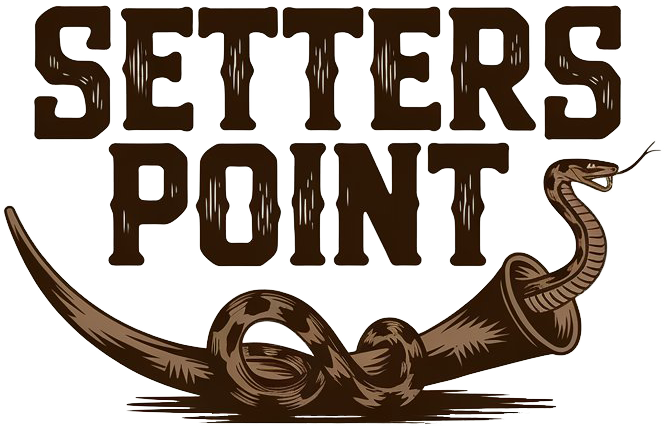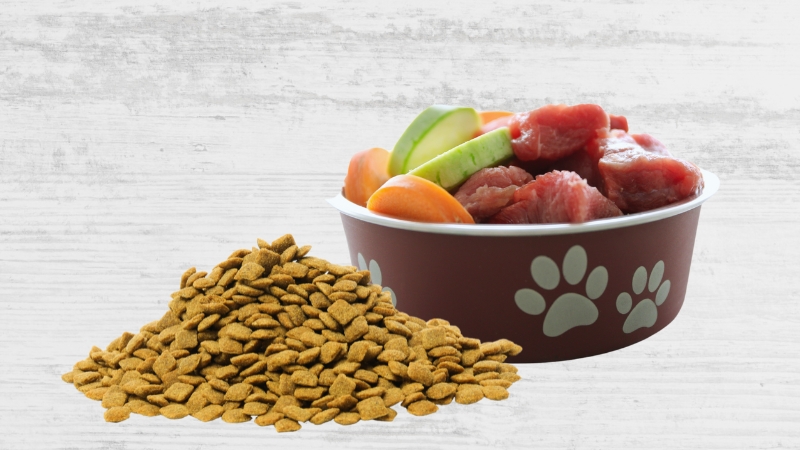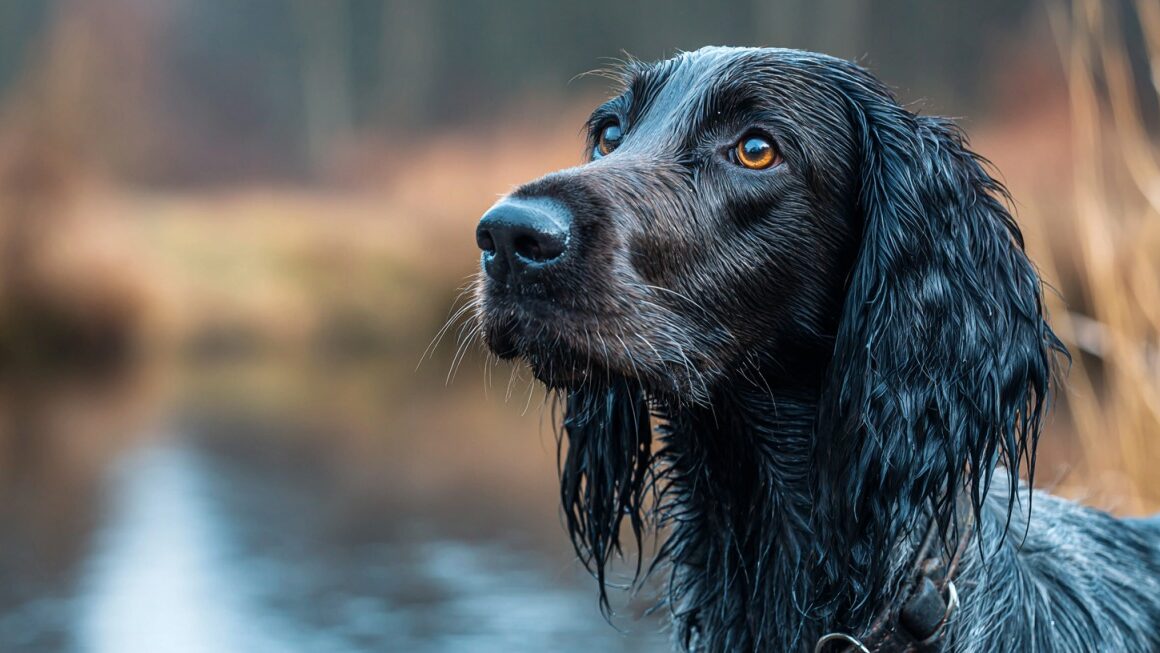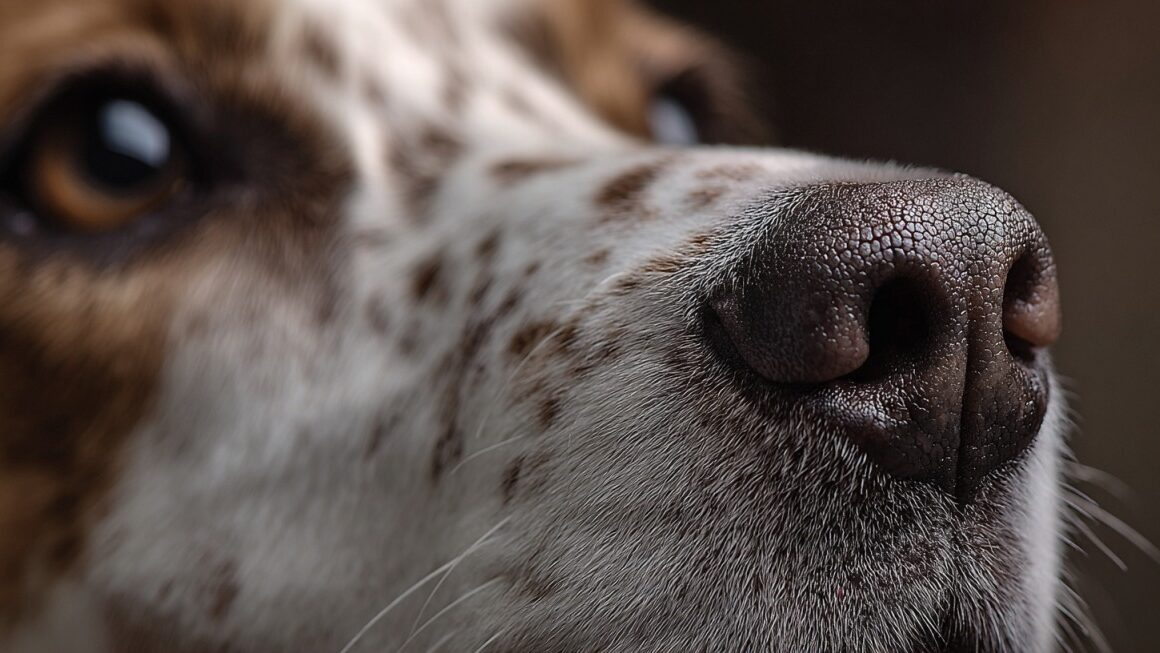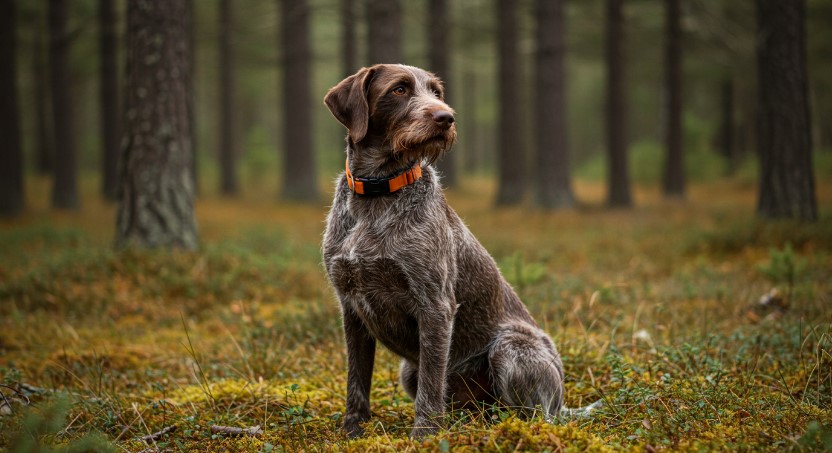When it comes to fueling active hunting breeds like German Shorthaired Pointers, Labrador Retrievers, and Vizslas, the answer isn’t one-size-fits-all, but it’s clear that diet matters.
These high-energy dogs burn through calories fast, often needing twice the caloric intake of a sedentary pet. Their food must support endurance, muscle recovery, joint health, and hydration.
So, what’s the verdict? Raw diets can offer higher protein, fresher ingredients, and natural enzymes, potentially boosting performance and recovery. But kibble—especially high-quality formulations—delivers balanced nutrition with ease of storage and handling, crucial for hunts and travel.
For most owners of active hunting dogs, the right choice depends on balancing performance needs with practical considerations like food safety, cost, and time.
Now, let’s see how real dogs thrive on each diet.
What’s in the Bowl? Raw vs. Kibble at a Glance
Let’s break down what’s actually in each type of food:
Aspect
Raw Diet
Kibble
Composition
Uncooked meat, bones, organs, fruits, and vegetables
Processed ingredients: meat meal, grains, legumes
Processing
Minimal, raw, and natural
High; extruded, cooked at high temperatures
Shelf Life
Short; needs freezing or refrigeration
Long shelf-stable at room temp
Preparation
Requires planning and safe handling
Convenient; pour and serve
Cost
Generally higher
More affordable
Performance and Health: Comparing Raw and Kibble
Raw Diet Pros and Cons
- Mimics a natural ancestral diet.
- Potentially improves coat condition and dental health.
- It can be tailored for high protein and fat needs.
- Risk of bacterial contamination (like Salmonella).
- Nutritional imbalances if not properly formulated.
- Time-consuming to prepare and store.
Kibble Pros and Cons
- Convenient and affordable.
- Formulated to meet nutritional standards.
- Easier to store and measure.
- Lower moisture content can affect hydration.
- Processing may reduce the bioavailability of nutrients.
- Some brands include fillers or lower-quality ingredients.
For high-performance dogs, the moisture content of raw diets can aid hydration, and the higher fat content can sustain long energy bursts. However, kibble’s convenience and nutrient consistency make it a practical choice, especially during travel or multi-day hunts.
Real-World Examples: Dogs on Raw vs. Kibble
Scout, a German Shorthaired Pointer
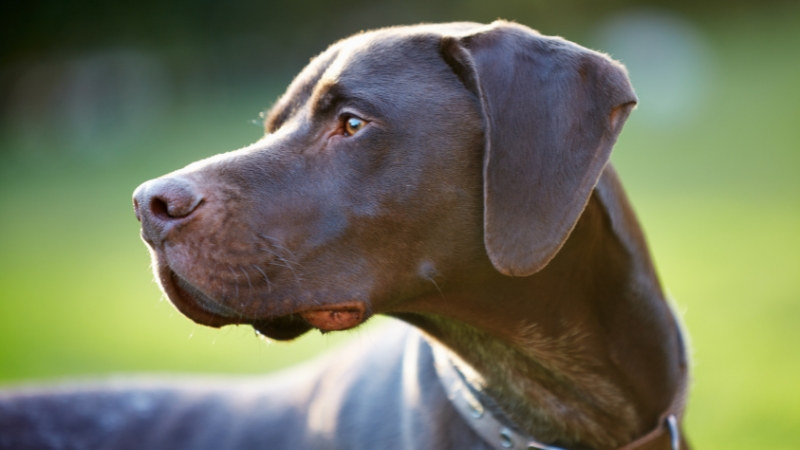
Scout’s owner transitioned him to a raw diet during hunting season, focusing on high-quality muscle meat, organ meat, and a balance of fats. The results? Scout’s stamina improved notably on long field days, and his coat turned glossier, with reduced shedding.
However, the owner found that meal prep was time-consuming, requiring daily planning, careful handling, and freezer space. When Scout’s family traveled for multi-day hunts, keeping the raw food safe and at the right temperature was a significant challenge.
Ranger, a Labrador Retriever
Ranger’s owner opted for a premium high-protein kibble formulated for working dogs. Ranger’s energy remained consistent, even on back-to-back hunting days, and his digestion was solid, with no signs of upset.
The kibble’s ease of transport and storage allowed the owner to pack for extended trips without worrying about spoilage or prep time. However, Ranger’s owner did notice that Ranger’s coat wasn’t as shiny as raw-fed dogs and that he needed extra hydration, as kibble lacks moisture.
Both Scout and Ranger thrive—but their owners made decisions based on their dogs’ needs and their own ability to manage the logistics. For some, raw offers performance perks but comes with handling challenges. For others, high-quality kibble provides balanced nutrition and convenience, essential for maintaining peak condition during hunting trips.
Practical Considerations: Cost, Storage, and Convenience
Factor
Raw
Kibble
Cost
$6–10 per day for a 60 lb active dog
$1–3 per day for premium kibble
Storage
Requires freezer space
Room temperature storage
Preparation Time
High; needs portioning and thawing
Low, pour, and serve
Food Safety
Needs strict handling to avoid bacteria
Generally safe
The Nutritional Demands of Active Hunting Breeds
View this post on Instagram
Active hunting dogs burn far more calories than sedentary pets. A typical hunting dog may need twice as many calories on active days as they do when resting. Key nutrients they need include:
- High-quality protein (25-35%) to repair muscles and support lean mass.
- Fat (15-30%) for sustained energy, since fat is a more concentrated energy source than carbohydrates.
- Carbohydrates (20-40%) for quick energy replenishment, particularly during long hunts.
- Vitamins and minerals for overall health, including bone and joint support.
- Hydration is critical, especially during warm weather or extended activity.
Compared to a couch-potato pet, hunting dogs need higher fat and protein levels and sometimes even different feeding frequencies.
Expert Opinions: Vets and Trainers Weigh In
Many vets recommend complete and balanced kibble for most owners because it’s easier to manage, especially for working dogs. However, canine nutritionists and some trainers acknowledge that raw diets, when carefully formulated, can offer benefits like improved coat quality, lean muscle mass, and sustained energy.
The key, they stress, is balance. Unbalanced raw feeding can cause nutritional deficiencies or imbalances, particularly in calcium, phosphorus, and certain vitamins. Meanwhile, high-quality kibble should be chosen based on protein sources, fat content, and absence of fillers.
A Hybrid Approach: Can You Combine Raw and Kibble?
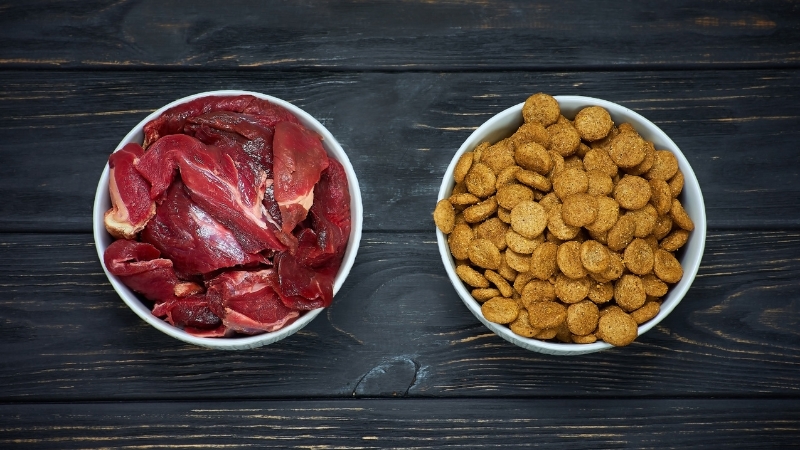
Yes, but with caution. Combining raw and kibble can be tricky because they digest at different rates, which may lead to digestive upset. If you choose this route:
- Feed raw and kibble at separate meals (e.g., raw in the morning, kibble in the evening).
- Monitor your dog’s digestion and performance closely.
- Work with a vet or canine nutritionist to ensure nutrient balance.
Tailoring the Diet: What to Consider
- Breed: Large hunting breeds may need more calories and joint support.
- Age: Puppies and seniors have different requirements.
- Activity Level: High-energy hunting days vs. rest days require caloric adjustment.
- Health: Allergies, digestive sensitivities, and metabolic issues must be considered.
- Owner Lifestyle: Do you have time for raw prep, or is kibble’s convenience better suited?
Sample Feeding Plan for a 60 lb Active Hunting Dog
Diet Type
Protein
Fat
Calories
Raw
30–35%
25–30%
2,000–2,400
Kibble
25–30%
15–25%
1,800–2,200
Note: Adjust portions based on activity level and health.
Conclusion
@rachelfusaro Full video in my bio under “raw vs kibble” where Dr. Brady & I deep dive on the latest pet food research as part of my Vet Chat/Expert Talk series!👇 PSA: we are NOT anti-kibble in any way shape or form. In fact, if you watch the full video, we both make it clear that while we believe fresher foods are optimal, there are ways to boost the bowl of kibble (which we share in our talk) Studies are linked in description of the full video for easy access! Dr. Brady has his doctorate in canine Nutrition & is a friend/mentor if mine, & there’s a lot of exciting content to come 🤓🤩❤️ We made the full YouTube video as a resource for you to share with your Vet the next time they tell yoy NOT to add (pet safe) fresh foods to the bowl 🥣 #rawdogfood #rawfeddog #rawdietfordogs #petfood #kibblevsraw #vetmed #holisticvet #dogmom #dogmomtips #dogtraining #newpuppy #dogfoodreview ♬ original sound – RachelFusaro.com 🐶
For active hunting breeds, both raw and kibble can support performance if chosen and managed correctly. Raw offers potential performance and health benefits but comes with higher cost, prep, and safety considerations.
Kibble provides convenience, consistency, and easier handling, especially important during hunts or travel.
The best diet? It depends. Consider your dog’s breed, activity level, health, and your ability to manage food prep and safety.
Consult with your vet or a canine nutritionist to create a plan that keeps your hunting partner healthy and performing at their best.
